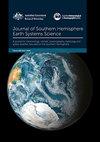Annual climate summary Australia (2016): strong El Niño gives way to strong negative IOD.
IF 3.6
4区 地球科学
Q1 Earth and Planetary Sciences
引用次数: 0
Abstract
Australian climate patterns and associated anomalies during 2016 are reviewed, with reference to relevant climate drivers for the Australian region. 2016 was the fourth-warmest year on record for Australia (annual anomaly of +0.87 °C), and the warmest year on record for the globe (the third year running that a new record has been set). Annual rainfall was above average for most of Australia, but below average for areas of the northern coasts between the Gascoyne in Western Australia and Townsville in Queensland, and pockets of coastal southeast Queensland and northeastern New South Wales.The very strong 2015–16 El Niño contributed to a very warm and dry first quarter. Autumn was the warmest on record nationally, with a significant nationwide heatwave occurring in late February to mid-March and bushfires at the start of the year in Victoria, Tasmania and Western Australia. In May the El Niño broke down and rainfall increased as a very strong negative Indian Ocean Dipole developed, lasting until November. While the central tropical Pacific approached La Niña thresholds during spring, a La Niña did not develop. The Southern Annual Mode commenced the year in a generally positive phase, was strongly positive in June and September, and was following by a strongly negative phase from late October until the end of the year.The period from May to September was record wet, relieving areas of drought in Queensland and southeastern Australia, but also causing flooding in multiple states. The last three months of the year saw a return to near-average rainfall and, while October and November were cooler than average for large areas, December was very warm for the eastern states.Ocean temperatures were also record warm for the Australian region during 2016, with an annual anomaly of +0.73 °C. Temperatures were particularly high during the first half of the year and resulted in widespread severe coral bleaching.年度气候摘要澳大利亚(2016):强El Niño让位于强负IOD。
参考澳大利亚地区的相关气候驱动因素,回顾了2016年澳大利亚气候模式和相关异常。2016年是澳大利亚有记录以来第四热的一年(年异常温度为+0.87°C),也是全球有记录以来最热的一年(连续第三年创下新记录)。澳大利亚大部分地区的年降雨量高于平均水平,但在西澳大利亚的加斯科因河和昆士兰州的汤斯维尔之间的北部海岸地区,以及昆士兰州东南部和新南威尔士州东北部的沿海地区,年降雨量低于平均水平。2015-16年超强厄尔尼诺Niño导致今年第一季度非常温暖干燥。今年秋天是澳大利亚有记录以来最热的一年,2月下旬至3月中旬出现了全国性的热浪,年初维多利亚州、塔斯马尼亚州和西澳大利亚州发生了森林大火。5月,El Niño破裂,降雨量增加,因为一个非常强的负印度洋偶极子形成,一直持续到11月。虽然热带太平洋中部在春季接近La Niña阈值,但La Niña没有发展。南方年度模式在一年开始时总体上是积极的阶段,在6月和9月是强烈的积极阶段,随后从10月下旬到年底是强烈的消极阶段。今年5月至9月是创纪录的多雨时期,缓解了昆士兰和澳大利亚东南部地区的干旱,但也在多个州引发了洪水。今年最后三个月的降雨量恢复到接近平均水平,虽然10月和11月的大部分地区比平均水平要冷,但12月对东部各州来说非常温暖。2016年,澳大利亚地区的海洋温度也创历史新高,年异常温度为+0.73°C。今年上半年的气温特别高,导致大面积严重的珊瑚白化。
本文章由计算机程序翻译,如有差异,请以英文原文为准。
求助全文
约1分钟内获得全文
求助全文
来源期刊

Journal of Southern Hemisphere Earth Systems Science
Earth and Planetary Sciences-Oceanography
CiteScore
8.10
自引率
8.30%
发文量
0
审稿时长
>12 weeks
期刊介绍:
The Journal of Southern Hemisphere Earth Systems Science (JSHESS) publishes broad areas of research with a distinct emphasis on the Southern Hemisphere. The scope of the Journal encompasses the study of the mean state, variability and change of the atmosphere, oceans, and land surface, including the cryosphere, from hemispheric to regional scales.
general circulation of the atmosphere and oceans,
climate change and variability ,
climate impacts,
climate modelling ,
past change in the climate system including palaeoclimate variability,
atmospheric dynamics,
synoptic meteorology,
mesoscale meteorology and severe weather,
tropical meteorology,
observation systems,
remote sensing of atmospheric, oceanic and land surface processes,
weather, climate and ocean prediction,
atmospheric and oceanic composition and chemistry,
physical oceanography,
air‐sea interactions,
coastal zone processes,
hydrology,
cryosphere‐atmosphere interactions,
land surface‐atmosphere interactions,
space weather, including impacts and mitigation on technology,
ionospheric, magnetospheric, auroral and space physics,
data assimilation applied to the above subject areas .
Authors are encouraged to contact the Editor for specific advice on whether the subject matter of a proposed submission is appropriate for the Journal of Southern Hemisphere Earth Systems Science.
 求助内容:
求助内容: 应助结果提醒方式:
应助结果提醒方式:


